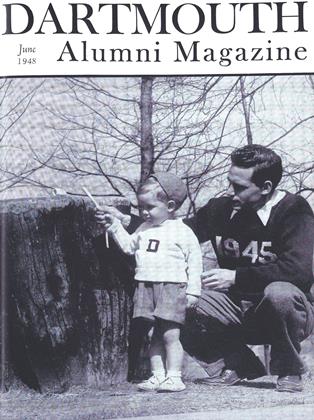Members of New Club Active in College Conferences
ALONG-STANDING void in Dartmouth undergraduate life has at last been filled by the formation of the Dartmouth Undergraduate Scientific Society. The sciences had long been neglected in the extracurricular life of the Dartmouth undergraduate; there was no organization on campus where the intelligent exchange of scientific knowledge could be carried on. Feeling the need for an organization which could accomplish this purpose, a few of the students in the various scientific fields met this spring and laid a tentative foundation for the society.
As the planning progressed, a definite set of purposes and a work program evolved. Organizational difficulties were gradually ironed out, the society was recognized officially by COSO, and the activities of the society commenced. Membership is open to all science majors, and others with an active interest in science, subject to the approval of an executive council representing the various science departments.
The first gap the society filled was that of having Dartmouth adequately represented at the various intercollegiate science conferences. Dartmouth, unlike other colleges of comparable and even lesser stature, had never participated in these intercollegiate conferences, where students were given the opportunity to exchange knowledge acquired through individual research. It previously had been a problem of no organization to handle the matter. The new society willingly undertook the task of letting the long silent Dartmouth scientific voice be heard in intercollegiate circles. On April 17, a group of Dartmouth students attended the Connecticut Valley Science Conference held in New London, Connecticut. The group presented papers in the fields of chemistry, botany, physics and psy chology. The papers varied from one by Joseph Masters '49 on the transient radia- tion of black bodies to the botany paper presented by Tom Sheehan '49 and John Cameron '48 on "Native Peat for Soil Im- provement." In the opinion of the eight undergraduates who attended the confer- ence, Dartmouth more than held its own. Having felt its oats, the society next made arrangements to have four papers read at the Eastern College Science Conference, which took place at Union College in New York. This time, Dartmouth dominated the gathering, which included the major Ivy League schools, presenting four of the twenty papers read. There is a strong possibility at the moment that Hanover may be the scene of this conference next spring if the procedural difficulties, can be ironed out. Such a meeting in Hanover will do a great deal to focus Dartmouth's attention and interest in the sciences.
At the moment, the Dartmouth Undergraduate Scientific Society is attracting a good deal of attention by the various lectures which it is sponsoring. Prof. George Z. Dimitroff discussed the 200-inch Palomar telescope and its implications. In a series of two lectures, Prof. Eugen Rosenstock-Huessy of the philosophy department has endeavored to clarify the basic nature of science. Prof. John Wolfenden, an addition to the chemistry department from Oxford, talked on scientific education in England. The large attendance at these lectures clearly indicates the interest in the sciences which really exists in Hanover.
The society has also done its best to encourage undergraduate scientific research and on several occasions has had papers read and discussed at its meetings. There is a possibility that next year may see the society sponsoring an undergraduate scientific magazine, devoted primarily to the publication of student research papers.
The role of science is becoming increasingly important in our complex society. The Dartmouth Undergraduate Scientific Society has ably undertaken the task of making the Dartmouth Indian more aware of the magnitude and scope of the sciences.
UNDERGRADUATE SCIENCE LEADERS: Chiefly responsible for launching the new student scientific society were, I. to r., Bill Grant '46, Joe Masters '48, John Waugh '49, Tom Sheehan '49 and Joe Smith '49.
 View Full Issue
View Full Issue
More From This Issue
-
 Books
BooksDeaths
June 1948 -
 Class Notes
Class Notes1918
June 1948 By ERNEST H. EARLEY, DONALD L. BARR, DAVID L. GARRATT -
 Class Notes
Class Notes1912
June 1948 By HENRY K. URION, RALPH D. PETTINGELL, ROSCOE G. GELLER -
 Article
ArticleExpedition to Hatteras
June 1948 By JOHN A. GUSTAFSON '48 -
 Article
ArticleA SENIOR'S VERDICT
June 1948 By PHILIP E. BOOTH '47 -
 Class Notes
Class Notes1943
June 1948 By FRED F. STOCKWELL, WILLIAM T. MAECK, JOHN A. KOSLOWSKI







